Overview of "Yamaha Motor Group Environmental Plan 2050"
Introducing an overview of the Yamaha Motor Group Environmental Plan 2050
Environmental Plan 2050

Yamaha Motor has a diverse range of products that allow users to enjoy interacting with nature in a healthy global environment, and we have grown by providing people around the world with free movement and fulfilling lives. We will therefore take responsibility for environmental conservation in the oceans, mountains and rivers which are our product fields, and minimize our effect on the environment.
In the Yamaha Motor Group Environmental Plan 2050, we set climate change, recycling of resources, and biodiversity as priority action areas, with carbon neutrality, a circular economy and nature positivity as targets to achieve.
Moreover, by increasing the environmental efficiency of our products, which are offered in over 180 countries and regions, across the whole supply chain which takes the Life Cycle Assessment (LCA) into account, we will reduce the CO2 emitted by our products when used for leisure, in industry and everyday life and contribute to the creation of a carbon-free society.
For resource recycling, there are demands for a switch from socio-economic activities based on mass production, consumption and disposal to a circular economy that efficiently uses limited resources.
For biodiversity, we are involved in activities at our business locations inside and outside Japan to conserve biodiversity in and around the region where we operate. Furthermore, we support activities that use Yamaha Motor's products, such as beach and lake cleaning using boats and ROVs, and forest conservation efforts involving the use of laser measurements with unmanned helicopters. We have also begun setting goals and considering initiatives according to the TNFD*, and we will promote activities aimed at becoming nature positive.
※TNFD:Taskforce on Nature-related Financial Disclosures
Overview of the Plan
| Action Themes | 2050 Targets | Priority Actions | |
|---|---|---|---|
| Climate Change 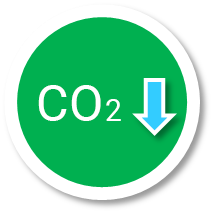 |
1 | Reduce CO2 emissions from products (Scope 3 Cat.11 86% or higher reduction compared to 2024) *Per unit sold |
※ICE: internal combustion engine |
| 2 | Reduce CO2 emissions from business locations (Scope 1, 2 Achieve carbon neutrality in 2035) |
|
|
| Resource Recycling  |
3 | Effective use and recycling of limited resources in products (Use of sustainable materials) |
|
| 4 | Effective utilization of limited resources and promotion of recycling at business sites (Zero landfill waste in business activities, waste reduction: basic unit 1% / year) |
|
|
Biodiversity |
4 | Strengthening of environmental conservation and biodiversity promotion activities in various countries and regions |
|
Management |
5 | Management |
|
- Scope 1: Direct greenhouse gases (GHG) emissions
- Scope 2:Indirect GHG emissions
*Indirect emissions from the use of electricity, heat, and steam supplied by other companies. - Scope 3:Indirect emissions other than those in Scopes 1 and 2
2050 Society
The current global population of 8 billion is predicted to reach 9.7 billion by 2050, increasing about 2 billion over the next three decades.
Economic growth in Africa and India, among other regions, will drive the world's consumption of primary energy, increasing 1.3-fold from the current level of 14.3 billion tons to 19.2 billion tons by 2050.
Based on these predictions, it is assumed that the world will face a significant shortage of resources and energy in 2050.
In terms of the global environment, the world is moving toward decarbonization in an effort to reduce CO2 emissions—believed to be the primary cause of global warming—shifting from fossil fuels to alternative energy sources in the use of primary energy. In light of these predictions and assumptions concerning society and our business environment in 2050, we identified long-term environmental issues.
Climate-related Risks and Opportunities
Action Themes |
Climate Change  |
Resource Recycling  |
Biodiversity  |
|---|---|---|---|
Risks |
|
|
|
Opportunities |
|
|
|
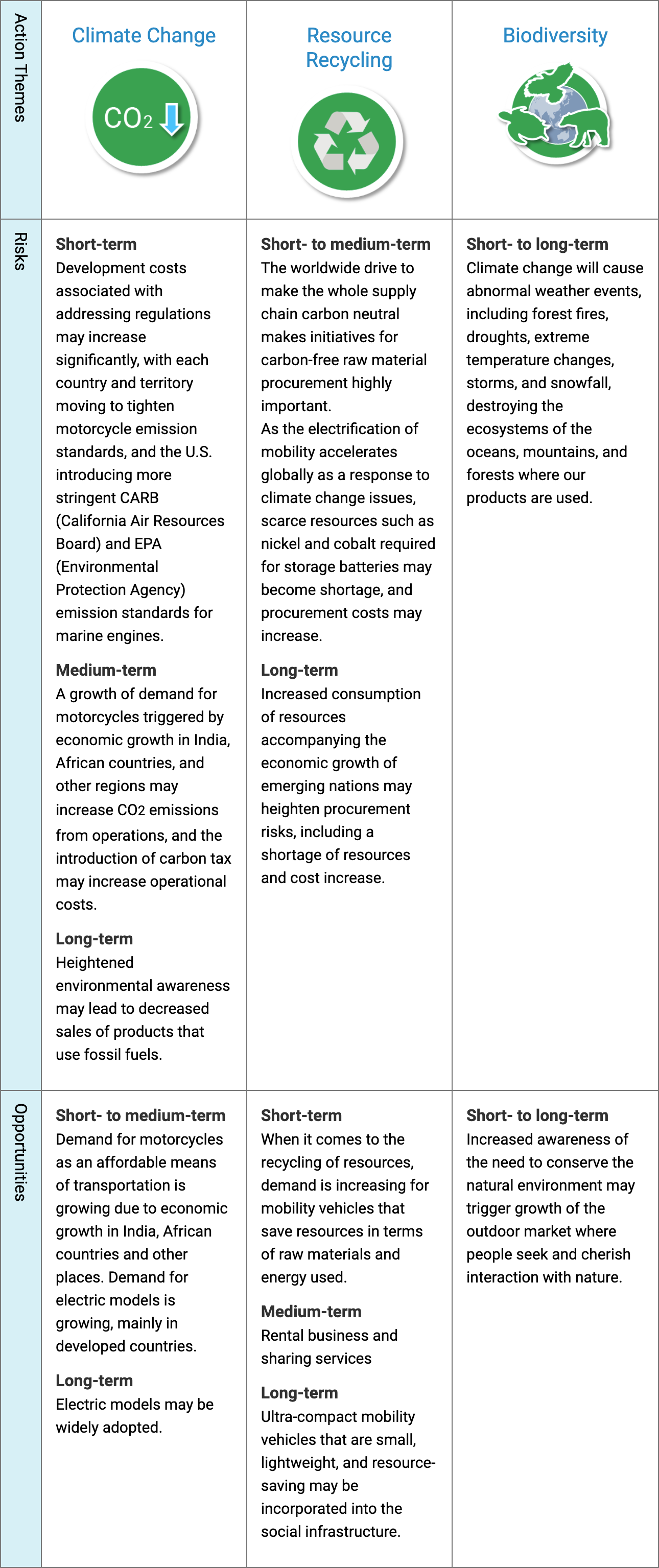
Task Force on Climate-related Financial Disclosures (TCFD) items
1. Governance

Climate change-related governance structure
The Board of Directors formulates policies on dealing with issues concerning sustainability and regularly reviews their implementation status.
With regard to issues concerning sustainability, the Board of Directors oversees the Sustainability Committee which conduct discussions based on advice from the Management Committee and meets three times a year, chaired by the President and Chief Executive Officer and comprising executive officers appointed by the Board of Directors.
| Sustainability Committee | Chair: Chief Strategy Officer (CSO) Members: Executive officers holding designated responsibilities |
For issues concerning sustainability, we positioned the environmental field in particular as an important area to be tackled by management, and established the Environment Committee, chaired by the executive officer assigned to the promotion of environmental activities.
The Environmental Committee meets six times a year to discuss policies and visions concerning environmental issues (climate change, resource recycling, biodiversity, etc.), formulate the Yamaha Motor Group's long-term environmental plan (Environmental Plan 2050), and conduct annual reviews of how each operating division has progressed against its targets.
Additionally, to encourage effective initiatives, materiality KPI results including carbon neutrality and external evaluations of ESG were linked to the compensation of management and executives.
| Environment Committee | Chair: Executive officer assigned to the promotion of environmental activities Committee members: Business and division activity promoters including the chief general managers of the businesses |

2. Strategy

Define scenarios

Categories of Shared Socioeconomic Pathway (SSP*) scenarios
IPCC The Sixth Assessment Report classifies five scenarios of projected trends in global socioeconomic development along two axes: socioeconomic measures for mitigation of climate change and socioeconomic challenges for adaptation.
※Shared Socioeconomic Pathways
- SSP1:A sustainable development scenario where both mitigation and adaptation are easy Low challenges.
- SSP2:A moderate development scenario for both mitigation and adaptation.
- SSP3:A development scenario of regional rivalry where both mitigation and adaptation are High challenges.
- SSP4:A development scenario with an unequal society, where mitigation is easy Low challenges but adaptation is High challenges.
- SSP5:A fossil fuel-dependent development scenario where mitigation is High challenges but adaptation is Low challenges.
In the IPCC Sixth Assessment Report, SSP1-1.9 was set as the scenario corresponding to the new target of a 1.5℃ change in the average global surface temperature due to the agreement made at COP26 to pursue efforts to limit the rise in temperature to 1.5℃ compared to pre-Industrial Revolution times. The report predicted that all five scenarios evaluated on the changes to the average global temperature by 2100 had a high likelihood of reaching an increase of 1.5°C by 2040, and thus there was the need for countries and corporations to intensify their climate change measures.
When Yamaha Motor formulated its approach to become carbon neutral by 2050, to cope with uncertainties (risk factors), we referred to the IPCC Sixth Assessment Report and considered each of the following scenarios: SSP1-1.9 or SSP1-2.6, and SSP3.
Evaluate Risks and Opportunities and Their Financial Impact
We evaluate the materiality of climate-related risks and opportunities based on whether they are likely to materialize in the short term, medium term, or long term, and the estimated scale of the resulting financial impact.
- Short term: May have an immediate impact on business performance (including possibilities that may materialize in a period of 0 to 3 years)
- Medium term: May necessitate a major adjustment of our strategies (including possibilities that may materialize in a period of 3 to 6 years)
- Long term: May radically impact the feasibility of our long-term strategies and business models (including possibilities that may materialize in a period of 6 years or more)
| Classification (scenario) |
Assessment target | Period | Response status | Financial impact | |
|---|---|---|---|---|---|
|
Transition risks |
Policy and Legal (SSP1) |
Development costs may increase due to compliance with the emission standards and CO2 emission regulations of various countries and regions | Short term |
The Regulations and Certification Division and local sales divisions obtain the latest information on tightening emissions standards and report it to the R&D division to help us respond to tightening standards in various countries. As a measure to minimize risks from suddenly tightened regulations in India and the ASEAN region, we develop our company's global models which comply with current standards in line with European standards. | While working to grow our existing businesses and develop new ones, we spent 136 billion yen on R&D expenses and growth strategies in FY2024, including measures to adapt to or mitigate climate change issues. One major effect of climate change on the company is that CO2 emissions from the use of our products account for approximately 94% of our total GHG emissions, and of that, about 90% are emitted by motorcycles. Motorcycles are our main product, making up 61% of our sales, so the R&D expenditure needed to comply with emissions standards has a major impact on our business. |
| Policy and Legal (SSP1) |
Introduction of carbon tax may increase operating costs We conduct manufacturing operations for our main motorcycle business at 27 locations in 16 countries, mainly in the ASEAN region. Fossil energy is used during processes like casting and painting. |
Medium term |
To minimize the risks associated with tightened energy standards in the countries and regions we are active in, the Production Technology Center and our environmental facility division collect information on regulatory trends pertaining to energy costs in various countries and regions. Moreover, the Environmental Committee deliberates and discusses energy-related investment plans, how to procure renewable energy and other matters, and the findings are reported to the Board of Directors following a review by the Management Committee. | The burden will increase to 37 billion yen/year if we assume a carbon tax on CO2 emissions of 10,000 yen/ton for our business activities from calculations based on CO2 emissions in 2024.* * Carbon Pricing Leadership Coalition (CPLC) Report: from 2030 carbon tax price forecasts |
|
| Technology (SSP1) |
Risk that demand for rare earths will increase and procuring raw material will become difficult once various manufacturers begin to accelerate electrification initiatives. | Short term |
Since the procurement and cost of compact batteries will be an issue, we have begun to work with other companies in the same industry to form a consortium to standardize battery standards to make batteries interoperable and develop infrastructure, and we are making efforts to popularize electric models. | ー | |
| Market (SSP1) |
Risk of reduced sales for ICE motorcycles due to bans on inner-city use of vehicles that use fossil fuels |
Long term |
We will develop mobility products that use next-generation power sources instead of fossil fuels (electric motorcycles, PAS, low-speed electric land cars), propose sharing services in collaboration with local governments, and pursue collaborations with partners aimed at the unification of social infrastructure focused on CASE, the latest trend in the automobile industry. | Sales of our motorcycles in developed countries in FY2024 were 390 billion yen. If sales of motorcycles equipped with gasoline-powered internal combustion engines dropped by 50% due to changes in preferences in markets in developed countries which are rapidly going carbon-free, it would reduce the company’s sales by 195 billion yen. | |
| Reputation (SSP1) |
Risk that investors and other stakeholders will consider the disclosure of information as insufficient | Medium term |
IR and SR staff of the Corporate Communication Division: Hold briefing sessions for individual investors and interviews for institutional investors | ー | |
Physical risks |
Acute (SSP3) |
Risk of extreme weather events impacting operations | Medium term |
We have identified damage from natural disasters as one of the Group's six major risks, and based on that identification we have made it obligatory to prepare and advance response plans for high-risk regions. When it comes to suppliers, we try to reduce risks by ensuring that we have adequate stock and by having a system in place for speedy responses when a disaster occurs, such as quickly identifying and confirming potential suppliers. | Sales of our motorcycles in developing nations in FY2024 were 1.16 trillion yen. In theory, if operations stopped for two weeks due to flooding in the ASEAN region, a supply delay of 120,000 motorcycles would occur which would cause a 4% reduction in motorcycle sales in developing nations, leading to a loss of 464 billion yen in sales. |
| Chronic (SSP3) |
Risk of long-term extreme weather impacting operations and sales | Long term |
Environmental managers assess the frequency and severity of onshore abnormal weather and heavy rain based on the evaluations in the IPCC's AR6 report, understand the level of their effects on our locations, and implement countermeasures. | ー |
| Classification | Assessment target | Period | Response status | Financial impact | |
|---|---|---|---|---|---|
Opportunities |
Resource Efficiency | Improved energy efficiency in production processes | Short term |
Implement theoretical-value-based production globally | 2022-2024 - Budget of 7 billion yen for carbon neutrality at production sites |
| Energy Source | Adopting renewable energy at production sites | Short term |
Introduce solar power generation globally Introduce CO2-free power sources to YMC |
2022-2024 - Budget of 4.7 billion yen for renewable energy at production sites | |
| Products/ Services |
Expand development of low carbon products Upgrade and expand sales of BEV products |
Medium term |
Launch 10 BV product models by 2024 Increase R&D facilities aimed at electrification and carbon-neutral fuels by 2024 |
Increased revenue due to demand for low carbon products | |
| Markets | Expand demand for our products tailored to the power sources and policies of individual countries and territories | Short term |
Launch the NEO'S electric scooter and the HARMO electric propeller in Europe | ー | |
| Access to environmentally-focused new markets and territories | Medium term |
Establish a Yamaha fund focused on the environment and resources To remove CO2 from the air, we invested in Andes Ag, Inc., a US-based startup that researches beneficial microorganism technologies . |
Total investment: 10.0 billion yen (15-year investment period) | ||
| Resilience | Increase revenue through products and services tailored to the energy policies and diverse energy sources of individual countries and territories | Long term |
In preparation for greater global demand for electrified products, Yamaha Motor is developing electrified versions of its products and expanding its lineup in order to establish systems capable of satisfying that demand. | R&D costs in 2024 were 136 billion yen |
Business activities and scope exposed to physical risks
According to the IPCC Sixth Assessment Report (AR6), “Climate change is already affecting every inhabited region across the globe, with human influence contributing to many observed changes in weather and climate extremes.”

IPCC AR6 WG1 reference area:
- ■ North America
- NWN(North-Western North America)、NEN(North-Eastern North America)、WNA(Western North America)、CNA(Central North America)、ENA(Eastern North America)
- ■ Central America
- NCA(Northern Central America)、SCA(Southern Central America)、CAR(Caribbean)
- ■ South America
- NWS(North-Western South America)、NSA(Northern South America)、NES(North-Eastern South America)、SAM(South American Monsoon)、SWS(South-Western South America)、SES(South-Eastern South America)、SSA(Southern South America)
- ■ Europe
- GIC(Greenland/Iceland)、NEU(Northern Europe)、WCE(Central and Western Europe)、EEU(Eastern Europe)、MED(Mediterranean)
- ■ Africa
- MED(Mediterranean)、SAH(Sahara)、WAF(Western Africa)、CAF(Central Africa)、NEAF(North-Eastern Africa)、SEAF(South-Eastern Africa)、WSAF(West Southern Africa)、ESAF(East Southern Africa)、MDG(Madagascar)
- ■ Asia
- RAR(Russian Arctic)、WSB(West Siberia)、 ESB(East Siberia)、RFE(Russian Far East)、WCA(West Central Asia)、ECA(East Central Asia)、TIB(Tibetan Plateau)、EAS(East Asia)、 ARP(Arabian Peninsula)、SAS(South Asia)、SEA(Southeast Asia)
- ■ Australasia
- NAU(Northern Australia)、CAU(Central Australia)、EAU(Eastern Australia)、NZ(New Zealand)
- ■ Small Islands
- CAR(Caribbean)、PAC(Pacific Small Islands)
In the section in AR6 about "Observed changes in heavy precipitation," out of the 11 areas that the company has manufacturing locations in, 7 areas and 27 locations were experiencing increases in heavy precipitation. There is the risk of operating shutdowns due to flooding of factories or fractured transportation in the supply chain for raw materials and parts caused by floods.
Regarding this risk, we are working on prevention and countermeasures by establishing rules to minimize damage by taking appropriate measures based on the "Business Continuity Regulations".The implementation status is reported and evaluated by the Sustainability Committee, which is chaired by the President and Executive Officer, and we are working to further improve the BCP level.
Yamaha Motor’s Net-zero CO2 Emissions (Carbon Neutrality) Strategy
Compact Mobility Vehicles with Low environmental impact
Yamaha Motor proposes compact mobility vehicles with low CO2 emissions and Low environmental impact throughout their life cycle, from raw materials to manufacturing, use, and disposal. For example, the CO2 emissions of two-wheeler vehicles are less than those of four-wheelers. In terms of the whole product life cycle, CO2 emission amounts are 70% less for ICE vehicles, and 75% less for Battery Electric Vehicles at the raw materials stage.
More effective CO2 emission reduction can be achieved through the reduction of CO2 emissions during the manufacture of batteries, and excellent charging facilities that utilize renewable energy sources.
Basic Policy
- Switch to efficient sources of power with smaller CO2 emissions.
- Promote the utilization of compact mobility vehicles with a low carbon footprint.
Multi-Pathway Initiatives
There is much we can do for the world as we work toward achieving carbon neutrality by 2050. In addition to electrification, one such initiative is the use of “sustainable fuels” that help reduce CO2 emissions. These initiatives are referred to as “multi-pathway,” and we are preparing to advance a variety of strategies.
| Main axis | Technological response | Effect | |
|---|---|---|---|
| ICE(internal combustion engine) | Enhancement of the efficiency of engines and drive trains | Fuel efficiency improvement | |
| HEVs (the main axis is motorized in S-HEVs) | |||
| De-carbonization of fuel | Synthetic Liquid Fuels | De-carbonization | |
| Hydrogen | |||
| Motorized | BEV | ||
| FCV (hydrogen fueled) | |||
ICE:Internal Combustion Engine; burns fuel to acquire moving force.
HEV:Hybrid Electric Vehicle; driven through the combination of an engine and motor.
BEV:Battery Electric Vehicle; drive a motor using battery power.
FCV:Fuel Cell Vehicle; power is generated using fuel cells to drive a motor.
CN fuel:Carbon-neutral fuel; moving force is acquired by burning Hydrogen, Biomass, Synthetic Liquid Fuels, and other renewable fuels.
Synthetic Liquid Fuels:Fuel obtained by synthesizing hydrogen and CO2, which are obtained by electrolyzing water with renewable energy.
Specific initiatives examples
World’s First Hydrogen-Powered Outboard Motor Displayed at 2024 SEMA
Yamaha Motor U.S.A. (YMUS) Marine Division collaborated with Roush Enterprises and Regulator Marine, Inc., to unveil the world’s first hydrogen-powered outboard motor for recreational boats at the Specialty Equipment Market Association (SEMA) Show.
Together with the hydrogen fuel system for powering the outboard motor designed by Roush and the specially designed boat hull by Regulator Marine, the concept of the H2 outboard motor was exhibited and introduced to over 160,000 visitors, including more than 2,300 members of the media, during the show.
By presenting a direction based on solutions utilizing multiple technologies, Yamaha promoted the idea of reducing CO₂ emissions through various technological approaches and emphasized the importance of cross-industry collaboration to realize these goals.
In the development of the hydrogen engine, Yamaha has partnered with a range of companies. These Initiatives align with Yamaha’s broader strategy to reduce CO2 emissions and contribute to a more sustainable future. By pursuing hydrogen as a clean and renewable energy source, Yamaha aims to advance its environmental goals while maintaining performance and reliability.
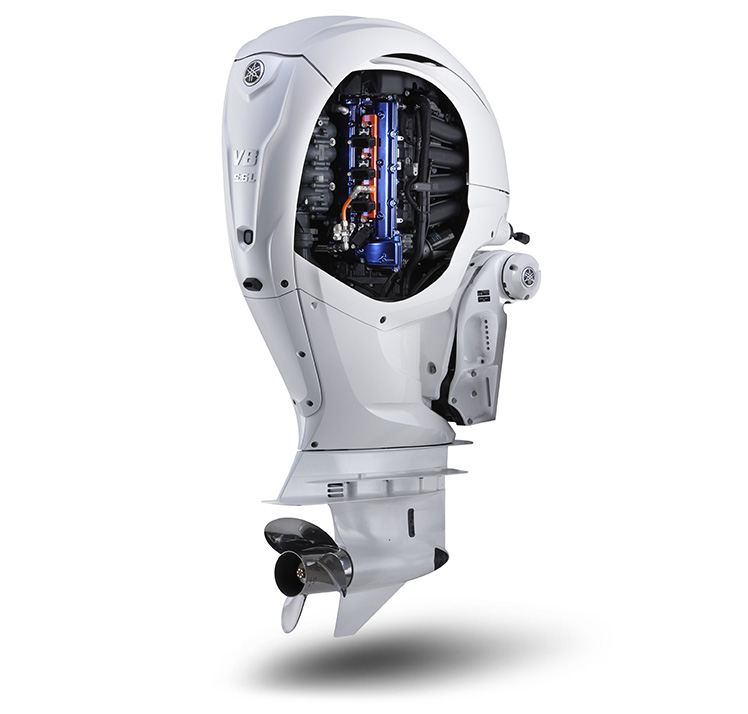
Investment in Electric Scooter Startup “World of River”
Yamaha Motor has invested in “World of River Limited, Inc.” (hereinafter “River”), a startup company engaged in the manufacture and sale of electric scooters in India.
River is a company involved in the development, manufacturing, and sale of electric scooters. In the world’s largest market for electric motorcycles—India—the company established a group company, “River Mobility Private Limited” (based in Bengaluru, India), and provides electric scooters with high quality and sophisticated design.
In India, the electric motorcycle market is rapidly expanding due to government support for domestic manufacturing and the promotion of electrification as part of energy diversification initiatives aimed at addressing environmental issues. Through this investment in River, Yamaha Motor will explore business collaboration with the company in the EV market.
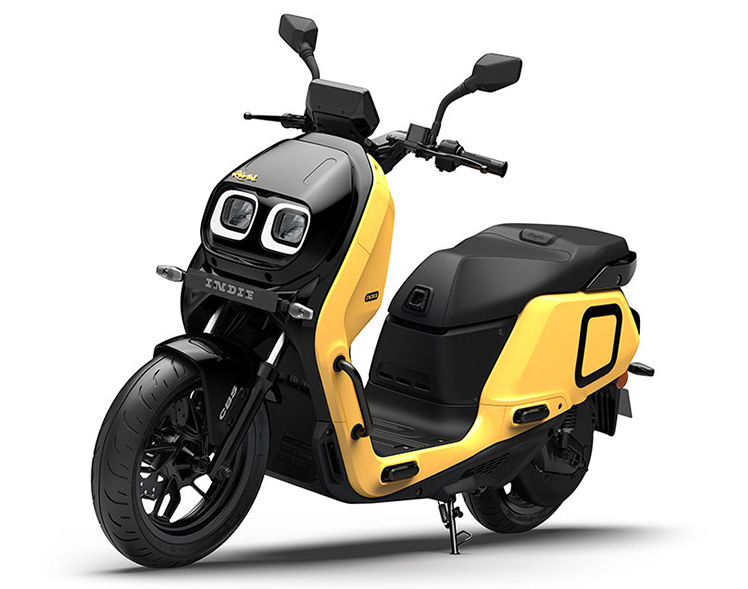
Acquisition of Marine Electric Propulsion Manufacturer “Torqeedo”
Yamaha Motor Co., Ltd. has signed a stock purchase agreement with Germany-based Deutz AG, the parent company of marine electric propulsion manufacturer Torqeedo GmbH (hereinafter “Torqeedo”), to acquire all shares of Torqeedo.
This acquisition aims to strengthen Yamaha Motor’s development capabilities in the “Electric” field of its Marine CASE strategy, which is being advanced as part of its Medium-Term Management Plan.
This acquisition is also meant to accelerate the Company's efforts for achieving carbon neutrality in the marine industry as well as aid in fast-tracking the establishment of a small electric propulsion lineup. Furthermore, by combining Torqeedo's assets with Yamaha Motor's decades of technical expertise and know-how in hull design, marine engines, and more will birth synergies for creating mid-range electric outboard motors as the Company aims to become a leader in the growing market for electric boat propulsion.
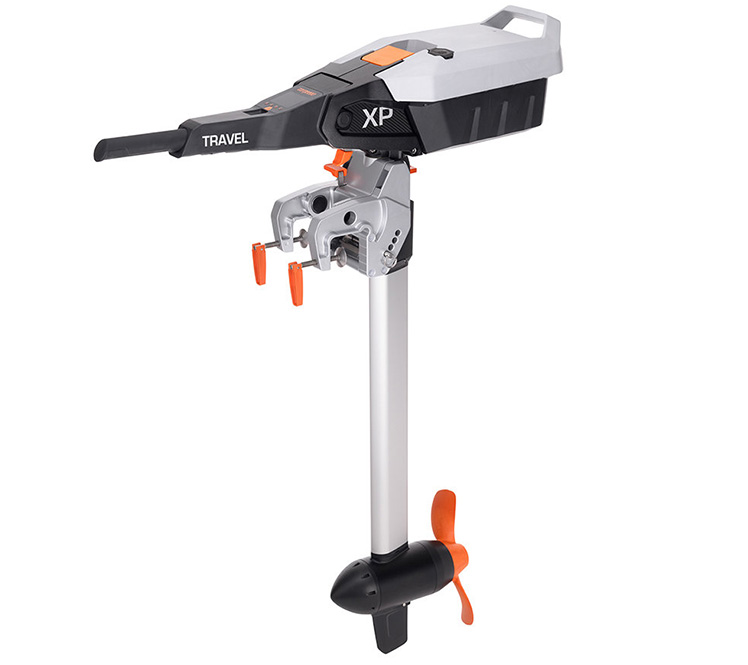
By region CO2 emissions from the use of sold products
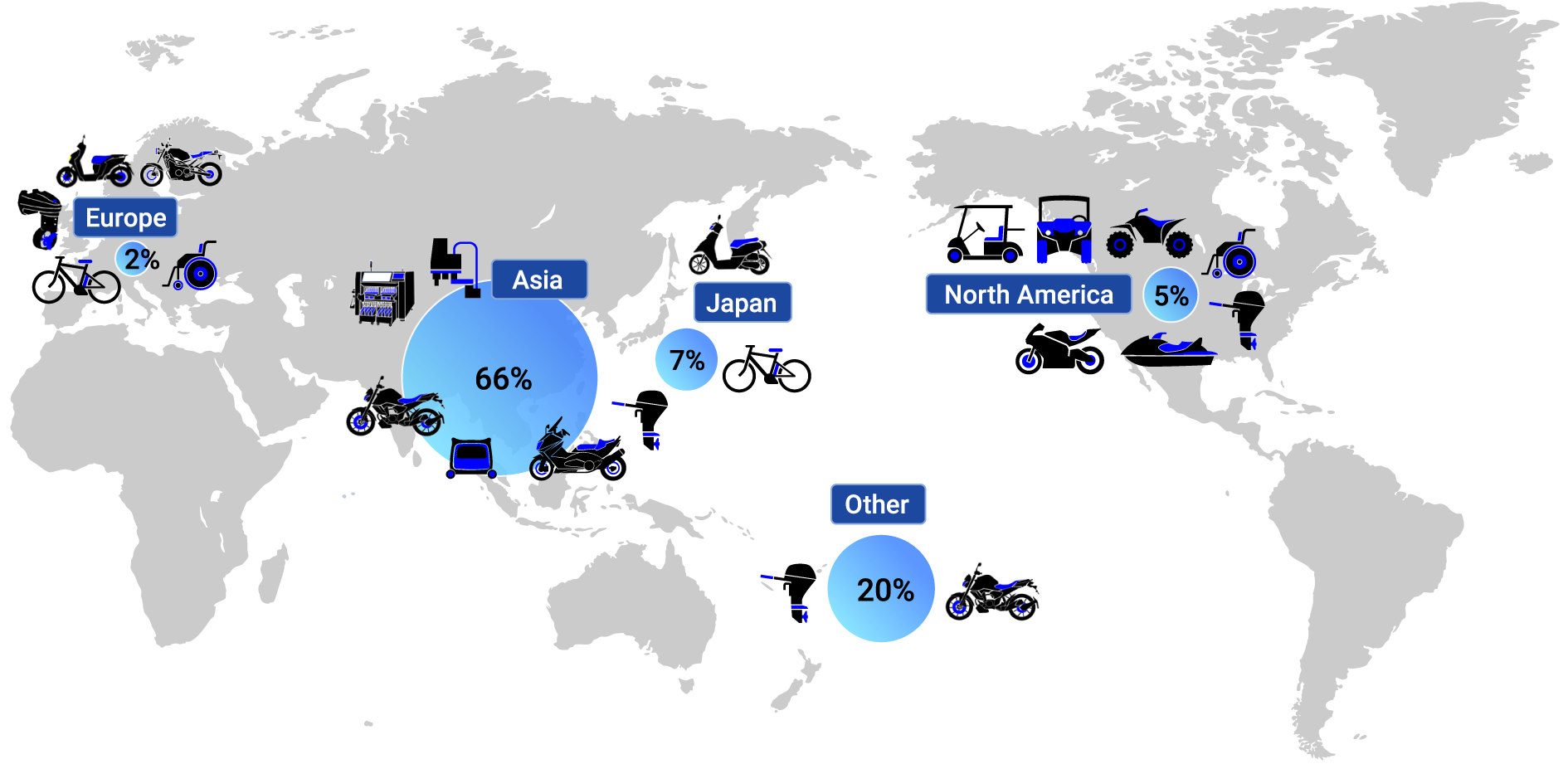


3. Risk Management

Process of Identifying and Evaluating Climate-related Risks
We identify and evaluate climate change risks from two perspectives: business strategy and business continuity.
Identification of Risks
Each operating division and functional division categorize short-term, medium-term, and long-term climate-related risks into "risks related to transitioning to a low-carbon economy" and "risks related to physical changes caused by climate change." Then, they consider the financial impacts of these risks on business, as well as the financial impacts on business with climate change mitigation measures and adaptation measures as opportunities for management reform, and identify risks and opportunities in the medium-term business plan.
Evaluation of Risks
The Environment Committee, chaired by the executive officer assigned to the promotion of environmental activities, evaluates specific initiatives undertaken as a business strategy on risks and opportunities identified by each operating division and functional division.
Process of Managing Climate-related Risks
The Environmental Committee manages the annual progress toward the goals and targets of specific initiatives undertaken as a business strategy on risks and opportunities identified by each operating division and functional division, and reports the results to the Sustainability Committee.
Specifically, each operating division and functional division considered NDC scenarios and two scenarios out of SSP1-1.9 or SSP1-2.6 and SSP3, using the information in the IPCC Sixth Assessment Report as a reference. They then evaluated the short-term, medium-term and long-term risks and opportunities and their impacts on business, strategies and finances and formulated specific numerical targets for 2030 (and 2035) as a step towards achieving carbon neutrality by 2050. The Environment Committee meets six times a year to deliberate on policies and visions related to environmental issues such as climate change, resource recycling, and biodiversity; formulate the Yamaha Motor Group’s long-term environmental plan (Environmental Plan 2050); and conduct annual reviews of each division’s progress toward its targets.
4. Indicators and Targets

Initiatives for "Climate Change"
※NDCs: Nationally determined contributions are the GHG reduction targets, measures, and efforts toward target achievement determined by each country on the basis of the Paris Agreement.
※ICE: Internal Combustion Engine; burns fuel to acquire moving force.
※BEV:Battery Electric Vehicle; motors are driven by battery power.
※CN fuel: Carbon-neutral fuel; moving force is acquired by burning Hydrogen, Biomass, Synthetic Liquid Fuels, and other renewable fuels.
※Synthetic Liquid Fuels: Fuel obtained by synthesizing hydrogen and CO2, which are obtained by electrolyzing water with renewable energy.
2050 (2030, 2035) targets
On its way to achieving carbon neutrality by 2050, the Yamaha Motor Group has set 2030 and 2035 as milestones for Scope 1, 2 and Scope 3 emissions and is promoting efforts to reduce CO2 emissions.
- Targets for 2050
-
- The whole supply chain must be carbon neutral
- Targets for 2035
-
- Scope 1, 2 : Achieve carbon neutrality
- Scope 3 Cat.11 : 27% reduction (compared to 2024)
- Targets for 2030
-
- Scope 1, 2 : 80% reduction (compared to 2010)
- Scope 3 Cat.11 : 13% reduction (compared to 2024)
2024 CO2 emission results and reduction results
| Scope 1, 2(t) | 373,278 | Scope 1 133,768 |
Scope 2 239,510 |
|---|---|---|---|
| Scope 3 Cat.11(t) | cat1 ~ 15 56,451,663 |
cat11 53,456,856 |
|
| 2010 (Base) |
2020 | 2021 | 2022 | 2023 | 2024 | |
|---|---|---|---|---|---|---|
| Emissions(t) | 662,261 | 442,533 | 500,903 | 465,326 | 402,658 | 373,278 |
| Emission per unit (t/net sales: billion yen) |
51.2 | 30.1 | 27.6 | 20.7 | 16.7 | 14.5 |
| Rate of reduction (compared to 2010) |
ー | ▲41.2% | ▲46.1% | ▲59.6% | ▲67.4% | ▲71.7% |
Scope 1 (Direct emissions from fossil fuel), Scope 2 (Indirect emissions from energy sources)
- Scope
: All 146 major facilities, including Yamaha Motor and its 138 consolidated subsidiaries
: Excluding fuel used for off-site vehicular transportation
: Excluding energy consumption by on-site suppliers
: Excluding acetylene
Coefficients referred to:5. Conversion factors used for heat consumption amount and CO2 emissions
Scope 3 Cat.11
| 2019 (Base) |
2020 | 2021 | 2022 | 2023 | |
|---|---|---|---|---|---|
| Emissions(t) | 29,344,372 | 21,961,065 | 26,016,843 | 26,506,968 | 24,784,905 |
| Emission per unit (t/unit sales) | 4.39 | 4.11 | 4.16 | 4.15 | 4.13 |
| Rate of reduction (compared to 2019) | ー | ▲6.4% | ▲5.2% | ▲5.5% | ▲5.9% |
Scope 3 Cat.11(2024 onward)※1
| 2024 (Base) |
|
|---|---|
| Emissions(t) | 53,456,856 |
| Emission per unit (t/unit sales) | 9.00 |
| Rate of reduction (compared to 2024) | ー |
Scope of calculation: Major products sold by the Yamaha Motor Group (motorcycles, outboard motors, electrically powered-assisted bicycles, golf cars, SMT equipment, etc.)
Calculation Overview: The emissions were calculated by multiplying the number of units sold during the target period in each region (Asia, Europe, North America, Japan, and others) by the estimated lifetime activity level*2 and the emission factor*3 for each product.
※1 We have revised the calculation method for motorcycles and outboard motors, which account for the majority of CO2 emissions under Scope 3 Category 11.
Accordingly, the CO2 emissions reduction targets of the Yamaha Motor Group Environmental Plan 2050 (hereinafter, the “Environmental Plan 2050”) have also been revised based on the new calculation method.
In addition, the reduction targets for 2030 and 2035 have been revised in light of recent market trends.
※2 The lifetime activity volume of products (conditions such as annual mileage and years of use) has been revised based on conditions disclosed by international organizations such as the IEA.
※3 Based on product fuel efficiency data and calculated using combustion emission coefficients derived from sources such as the Ministry of the Environment and the IEA World Energy Outlook 2024 Free Dataset.
Initiatives for "Resource Recycling"
Use of sustainable raw materials in products
- 100% sustainable raw materials by 2050
Reduce waste generated by production activities
- Raise awareness of a globally shared definition of waste materials
- Obtain a grasp of waste amounts utilizing a global tabulation system
- Carry out on-site surveys, extract and grasp issues
Reduction of water usage in production activities
- Continue obtaining an understanding of the water consumption amounts of each Group company
- Aim to minimize water risks* through measures corresponding to the water risks of each country and region
* Water risks are indexes related to water supply and demand that were uniquely established by Yamaha Motor using Aqueduct, published by the World Resources Institute, and other materials as reference
Environmental Management
2050: Eliminate all harmful substances contained in products
2030: Strengthen compliance with environmental laws and regulations, and control of chemicals in products
- Reduce environmentally hazardous substances in products
- Risk management of the control of environmentally hazardous substances


